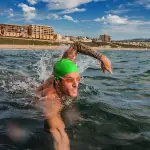There is no time for hesitation when sighting. Take your inhale, and just as you would normally return your face into the water to exhale, extend your head forward to sight while exhaling. If you don't get a clear view during this window of time, do not hesitate. Instead, continue with your stroke cycle--rolling into the next inhale and sight again on the next stroke. The number of times you should sight is subjective and based on how difficult it is to see in front of you due to the conditions at hand. I recommend sighting more often than not--every two to four stroke cycles-- guaranteeing your most direct course possible.
Controlling the Variables on Race Day
Being prepared for an open water swim will put you mentally at ease, and you'll be confident that you will navigate the course masterfully and swim efficiently. From the shore, take a look at the buoys of the swim course to get an idea of what you will see while out in the water. Find a landmark on land, a fixed object that stands out such as a telephone tower. This marker will help you reference where you are relative to the buoy at all times, especially in cases when you're unable to see the buoy.
More: Swimming Shoulder Injury Prevention for Triathletes
If the race allows, do a warm-up swim out to the first buoy so that you have a sense of its distance from the starting point. This will also help you gauge the effort you will need to give at the race start. Once you're at the first buoy, position yourself toward the second buoy so that you know what to expect at this point of the swim. Again, try to find a fixed reference point on land that you can easily see while swimming.
It's unrealistic to think you'll be able to train in the open water all the time, but this doesn't discount the importance of sighting practice. It's easy to incorporate sighting--even while pool training. Start by sighting once or twice each length of your main set, building up to the point that you're able to comfortably maintain sighting mechanics for the bulk of your workouts. Next, swim in your local body of water and have fun implementing these newly developed skills and confidence.



